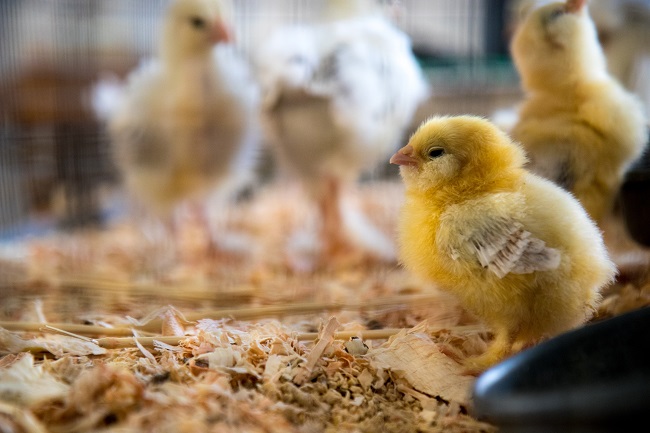The main things to attend to for the first 60 days of a chicks’ life are housing, temperature, food and water, cleanliness. Chicks should be kept indoors (or in a heated brooder) until they have their feathers, which appear at about 5-8 weeks.

The chicks’ first home is called a “brooder”. For one-time or once-in-a-while use, a cardboard box works just fine. A cage suitable for a rabbit or guinea pig is terrific and easy to clean. Some people even use an aquarium. The bottom should have a layer of clean litter (pine shavings or similar) or newspaper. The litter should be changed out every couple of days, and never allowed to remain damp – cleanliness is very important at this stage.
Baby chicks are prone to several diseases, most of which can be avoided with proper sanitation. The size of the brooder depends on how many chicks you have – the chicks should have enough room to move around, and to lay down and sleep. You also need to have enough space in it for a waterer and a feeder. When the chicks are a month old, add a low roost – a stick or piece of wood dowelling about 4″ off the floor of the brooder. The chicks will jump on it and may even begin sleeping there. Don’t put the roost directly under the light, it will be too hot. The brooder can be heated by using a light bulb with a reflector, available at any hardware store. A 100-watt bulb is usually fine, though some people use an actual heat lamp. The temperature should be 90-100 degrees for the first week or so, then can be reduced by 5 degrees each week thereafter, until the chicks have their feathers (5-8 weeks old). A thermometer in the brooder is helpful, but you can tell if the temperature is right by how the chicks behave. If they are panting and/or huddling in corners farthest from the light, they are too hot. If they huddle together in a ball under the light, they are too cold. You can adjust the distance of the light or change the wattage of the bulb.
Clean, fresh water must always be available to your chicks. Get at least a medium size waterer – chicks drink a lot of water. The plastic kind is easy to clean, inexpensive, lightweight and they can’t tip it over. They also poop everywhere including right into their water; clean the waterer at least once a day (depending on how crowded it is, even twice a day).
Even baby chicks will naturally scratch at their food, so a feeder that (more or less) keeps the food in one place is good. Again, cleanliness is important; the chicks will poop right into their own food, so you must clean and refill it often. Chicks start out with “crumbles“. It is specially formulated for their dietary needs; it comes both medicated and not. If you don’t use medicated feed, you run the risk that Coccidiosis will infect and wipe out as much as 90% of your chicks. If you choose nonmedicated feed, pay more attention to cleanliness. The feed is a complete food – no other food is necessary. However, feeding your chicks treats can be fun. After the first week or two, you can give them a worm or a bug or two from your garden to play with and eat. Greens are not recommended because they can cause diarrhea like symptoms. When droppings are loose, a condition may develop called “pasting up”, where droppings stick to the vent area and harden up, preventing the chick from eliminating. Check the chicks for pasting often, if you see this, clean off the vent area (you can use a moist towel or even some mineral oil).
Chicks are insatiably curious – after the first week or two, they can be put outside for short periods of time if the temperature is warm. They must be watched at this age, chicks can move fast, squeeze into small spaces, and are helpless against a variety of predators, including the family dog or cat. If they have bonded to you (the first large thing a baby chick sees is forever it’s ‘mama’, this is called “imprinting”), they will follow you around. Chickens become fond of their owners; some will come when you call them.
Related Articles & Free Email Newsletter Sign Up
Everything You Need to Know About Waterfowl
How to Prevent Disease in Waterfowl


Comment here